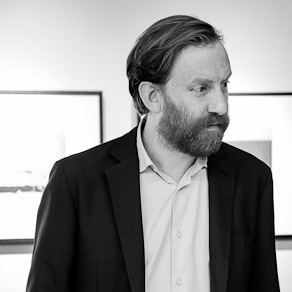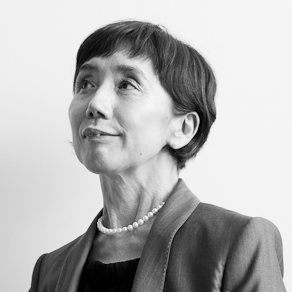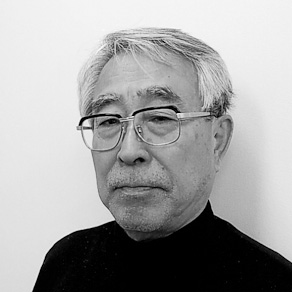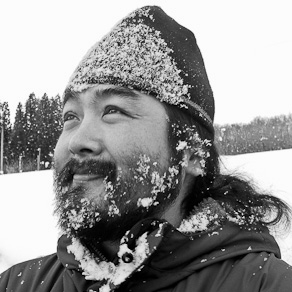2014 Jurors
There were a total of 131 entries for the 2014 Hariban Award. Of these, 51 passed the first round of judging: 27 from Japan, 17 from the West, and 7 from Asia. In the second round, 10 were selected. I would like to note that it was a difficult duty being a judge, as all the works demonstrated a high standard of quality. It can be said that this reflects the current situation in the photography world; the possibilities of photographic expression vary widely, and sometimes it’s not easy to make a judgment.
In the second round of judging, 35% of all submissions were so-called straight photography, 14% were pictorial expressions, and the rest (a majority of 51%) used techniques that expressed the artist’s unique vision such as photo collages, photograms, solarization and even the wet plate collodion process.
— Takumi Suzuki, CEO Benrido, Inc.
・
Tsuguo Tada
Special Editorial Advisor, Iwanami Shoten
Awoiska van der Molen, winner of the 2014 Hariban Award, visited and stayed on several isolated European islands, far away from worldly things and city noises. On one island, after sunset, a delicate procession of lights is seen as hikers weave their way up the gentle slope of a hill that stands in the midst of a vast meadow.
On another island, bare jagged rocks in the mist seem to reject any human presence. Among the rocks are moss and ferns softly illuminated in the woods. These islands are a world of silence. The photographer inhabits a landscape not unlike that from a time much earlier in earth’s creation, and has expressed this estrangement in her photographs.
It has been 180 years since the invention of photography. Various materials, equipment and techniques have been invented, and now we are in the digital age. Of the surviving processes, the collotype technique is one of the oldest in the history of photography.
It is a rare photographic technique with exquisite reproducibility, and durability beyond comparison, underpinned by a long tradition of dedicated craftsmanship.
I think the Hariban Award presents an opportunity to create a whole new standard and new way of looking at the various modes of expression in contemporary photography via the medium of collotype.
BIO
Tsuguo Tada serves as Special Editorial Advisor to Tokyo’s well-respected Iwanami Shoten publishing house, where he founded the Fine Arts and Photography department. In addition to his extensive publishing experience, he has also curated and overseen exhibitions of photographic works by Atget, Brassali, Hiroshi Hamaya, William Klein, Jacques Henri Lartigue and Alfred Stieglitz. Recent projects include The “Metamorphosis of Japan After the War” at the Berlin Museum of Photography and “Beyond the Divide at the Getty Museum.”
・
Naoko Ohta
Independent Curator, Gallery 916 / Tokyo – Ga Project
As a person who works in the photographic world, it is always a great pleasure to jury international competitions, a duty that brings me into contact with a variety of new work. This competition was especially satisfying because the winning photographs are to be printed using the collotype process, which is still one of the finest existing techniques. I look forward to seeing how these photographs, already of a very high quality, will be enhanced as collotypes. In this case, winning the award is not the end result, but the beginning of a new life for the selected works.
In Kyoto, the Japanese style of collotype printing developed uniquely, influenced by various traditional techniques. I think Japanese collotype production reconciles two challenges: the preservation of a time-honored cultural tradition, and the development of a new mode of artistic expression that was initiated by the advent of photography.
The word “photography” means “light picture,” yet the Japanese word for photography is “shashin”, which means “copy truth,” or “trace truth.” There seems to be a difference between the Western and Japanese understanding, even when encountering the same photograph. I was honored to participate in the Hariban Award competition as one of three jurors, each with a unique point of view.
A sincere attitude towards the act of looking was evident in many of the submissions. Grand Prize recipient Awoiska van der Molen’s portfolio stood out because it demonstrated a great dedication to witnessing the timeless nature of her subjects. The landscapes in her photographs are filtered through her vision, which has an exceptional clairvoyant power to evoke a sense of some existence beyond our field of vision.
Reproducing images in printed media makes it possible to share their beauty widely. The collotype process is used for printing go-shintai, holy objects such as calligraphy and sutra manuscripts. Collotypes have the power to reproduce the depth and detail of these works faithfully, awakening the hidden messages and spirits within them. Collotypes are produced so that many people see them again and again over time. If the quality of the printing broadens the possibilities of photography, I think we should find and share these new possibilities and new standards, which will resonate both photography and the collotype process in the future.
Finally, I would like to add that in order to develop compelling photography of the future, we must not forget the enterprising spirit of the tradition we have inherited. We should continue to challenge the possibilities of the photographic medium and the collotype process.
BIO
Naoko Ohta is president and CEO of Klee, Inc., which provides a wide range of art- related services, including production of international exhibitions, artist representation, and editorial direction and publication of books and photography collections. Recent projects include the exhibition L’Art de Rosanjin at the Museé Guimet in Paris.
・
Simon Baker
Curator of Photography and International Art, Tate Modern
Simon Baker is an art historian and the Curator of Photography and International Art at London’s Tate Modern. After receiving a PhD from University College London and beginning an academic career as a lecturer in the history of photography, surrealism, and contemporary art, he gradually became involved in curating exhibitions. In 2009, he joined Tate, where he continues to work collaboratively to create exhibitions that integrate photographic work into the museum’s diverse collection of contemporary art.
・
Tsuyoshi Ito
Program Director, Project Basho / ONWARD
Tsuyoshi Ito was born in Tokyo and later moved to the United States to attend Temple University in Philadelphia. Noticing a void in Philadelphia’s photography community, he founded Project Basho in 2002, providing photography classes and darkroom space for working artists. Project Basho now includes ONWARD, an international photography competition. Tsuyoshi is particularly interested in historical processes, including techniques that bridge old and new.
Category
Hariban Award 2014




